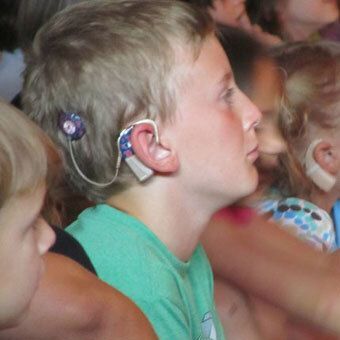Cochlear Implants & Hearing Aids
Today’s cochlear implants and hearing aids provide excellent auditory access to speech.

What is a cochlear implant?
The organ of hearing is a pea-sized structure in the inner ear called the cochlea. Tiny, delicate hair cells in the cochlea communicate sound signals to the auditory nerve brain, allowing a person to hear different sounds. If these delicate hair cells are damaged, or missing, the result is a hearing loss.
A cochlear implant bypasses the damaged part of the ear and sends sound signals directly to the auditory nerve.
This device consists of two parts:
- an internal device that has electrodes that are surgically implanted in the cochlea; and,
- an external device that contains a microphone, wire, magnet and a processor that is worn on the outside of the head or body.
An implant does not restore or create normal hearing, but it can give a person who is deaf or hard of hearing access to sound, particularly the sounds of speech.
There are now more than 60,000 cochlear implant recipients worldwide who are listening and speaking through the use of technology and AO/AV therapy. Maine Medical Center now provides cochlear implants to adult patients. Hear ME now is partnering with Maine Medical Partners Otolaryngology to provide comprehensive care.
What is a hearing aid?
When a person with hearing loss still has some access to sound through their cochlea, hearing aids may be used to maximize that access. A hearing aid is an electronic, battery-operated device that amplifies sound to improve detection and clarity. It collects sounds from the environment via a microphone, amplifies those sounds and then directs the amplified signal into the user’s ear through a tiny speaker.
It is important to provide infants who are deaf and hard of hearing with hearing aids as early as possible, ideally within 1 – 2 months of age, to maximize the early growth of the auditory brain that happens in response to stimulation from the environment.
Finding the correct hearing aid for a baby with hearing loss is an important step. Children are typically fit with a type of hearing aid known as a behind-the-ear (BTE) hearing aid. Today’s technology enables hearing health professionals to fit even very young babies with hearing aids that meet their needs.
By working closely with audiologists, speech language pathologists and experienced deaf educators like the team at hear ME now!, children with cochlear implants or hearing aids learn to maximize their access to sound to develop a full range of listening, language and speaking skills.
Contact us to see how hear ME now can help.

